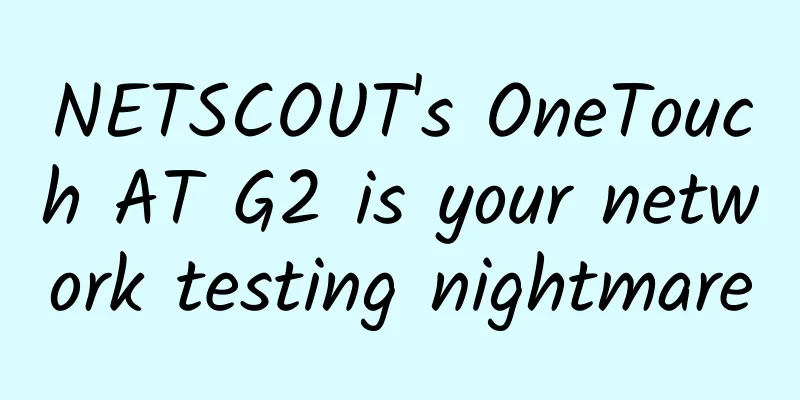NETSCOUT's OneTouch AT G2 is your network testing nightmare

|
[51CTO.com original article] Xiao Nie just returned to his workstation from the weekly meeting of the school's information department. He felt that he was facing unprecedented pressure. He joked that he was almost "at the end of his rope". The reason can be traced back to last month, when Xiao Nie's university opened two new campuses. The leaders clearly instructed the information department to connect the existing education network with the traditional telephone network and expand VoIP applications by taking advantage of the comprehensive wiring work of the new and old campuses. In this way, not only is the expansion simple, but also the cross-regional voice networking can integrate the voice resources of multiple campuses; the most important thing is that it can save a lot of communication costs. In order to complete the task assigned by the leader, Xiao Nie quickly deployed a complete set of IP voice phones and voice gateway solutions in all campuses after careful screening and evaluation. Unexpectedly, the information department was plagued by troubles: teachers kept calling to complain about serious call delays, unclear voices and frequent disconnections; students complained that they often couldn't get through, and even if they did get through, they couldn't hear the other party talking, but the echo of their own voices was clearly audible on the phone; finally, even the leader repeatedly asked the information department to have a "sense of responsibility" and be responsible for the quality of information engineering... If you want to do your work well, you must first sharpen your tools. In fact, Xiao Nie really didn't dare to take it lightly. He tried almost every trick in the book - he first checked and searched the web operation logs of the administrator and extension users, trying to find clues, but the workload of checking the massive logs was too heavy; later he used packet capture tools, hoping to use IP PING tools and route tracking tools to debug the device, but the free tools provided by the manufacturer can only capture limited information and cannot fully reflect the overall picture of the network. Xiao Nie even tried to use recording tools to record and debug the FXO relay lines, but the analysis capabilities of these tools on the Internet are extremely limited, and even if problems are found, they are very broad and cannot be accurately located; finally, Xiao Nie even used "factory settings restoration" and tried "backup and restore", but these methods had little effect, and could not quickly diagnose the cause and location of the fault and truly solve the problem. In addition, Xiao Nie has limited professional knowledge in the field of Internet voice calls, and is unable to improve the quality of VoIP. "Is there a tool that can quickly analyze and locate online VoIP applications to help a non-professional quickly find the cause of the fault and isolate the problem?" Xiao Nie couldn't help asking. The answer is of course yes. If Xiao Nie had a NETSCOUT OneTouch AT G2 handheld network tester in his hand during the test acceptance stage, all of Xiao Nie’s previous difficulties would have been solved.
OneTouch AT G2: The Swiss Army Knife of Network Testing Tools What is the NETSCOUT OneTouch AT G2 handheld network tester? In fact, the OneTouch AT G2 is an automatic all-in-one network tester for Ethernet and Wi-Fi troubleshooting and performance verification. Many industry insiders compare the OneTouch AT G2 to a Swiss Army knife, which is not only versatile, but also powerful enough for each single tool. The VoIP analysis function mentioned above is just one of the many network test functions of the OneTouch AT G2, but its ability to analyze faults is far beyond the reach of many VoIP test tools.
In a nutshell, OneTouch AT G2 enables online connection between IP phones and the network for real-time troubleshooting and analysis. It is placed at different network connection locations to easily detect various VoIP problems such as network connectivity, jitter, packet loss, echo, latency, etc. OneTouch AT G2 is very comprehensive in revealing issues related to PoE, DHCP, TFTP, SIP, and SCCP. This test can also provide insight into unencrypted SIP and SCCP traffic to debug VoIP phone problems and quantify VoIP call quality. If Xiao Nie had OneTouch AT G2 when evaluating VoIP solutions, he could connect the device in the online state and gain insight into real-time VoIP traffic to quickly diagnose IP phone startup and call control issues. During the pre-deployment assessment process, he could use OneTouch AT G2 to measure key call quality indicators and identify whether the network link is ready for VoIP. After deployment, when users report problems, Xiao Nie can also use OneTouch AT G2 to directly view the call progress, monitor VoIP calls from the edge of the network, and troubleshoot VoIP problems, so there is no need to perform complex and time-consuming packet capture and post-capture decoding operations. Take packet loss as an example. It is well known that many network problems can cause packet loss. A common cause of packet loss is overuse of WAN links. Other reasons include duplex mode mismatch, route flapping on routers, etc. In addition, network operation and maintenance personnel often overlook the cause of cable damage when checking VoIP faults. Cable damage includes miswires, open circuits, short circuits, and excessive length of untwisted sections of cables. In some cases, there will be no problem when the phone connects to the network, it can receive a DHCP address, and even initiate a call. However, this cable fault will cause FCS errors on some of the frames on it, which need to be discarded at the switch or phone. Usually, these problems occur intermittently and are not easy to detect, but the OneTouch AT G2's detection is very comprehensive, including cable monitoring, which makes it easy to find and eliminate problems. More specifically, the OneTouch AT G2 provides a lot of statistical data when analyzing VoIP problems, allowing people to more objectively measure the impact of these quality problems. It is also worth mentioning that the OneTouch AT G2 can also capture wired, Wi-Fi, VoIP and autotest traffic, filtering the traffic to capture the most important parts. Online capture avoids the complexity, time and cost of configuring switch mirror ports or installing separate taps. Although there are many capture tools on the market, the capture capabilities of different tools are still quite different in terms of actual application effects. The capture function of OneTouch AT G2 can capture wired traffic of a single port, a set of two ports, or an online port between a client device and a network. In addition, in order to help operation and maintenance personnel find problems more easily, OneTouch AT G2 also supports exporting capture files to a computer so that operation and maintenance personnel can decode and analyze them with protocol analysis software. Objectively speaking, OneTouch AT G2 can be regarded as a very comprehensive and practical function. New PoE standards will trigger a new peak of applications. OneTouch AT G2 is ready As mentioned above, OneTouch AT G2 is a network tester. In addition to VoIP analysis, its main task is to help network operators reduce the time spent on network verification and solving network performance problems. Functionally, it provides all-in-one testing for Ethernet, Wi-Fi, network services, and application performance. Engineers can not only predefine multiple AutoTest profiles, but also allow on-site operators to quickly verify comprehensive key parameters from the perspective of end users and use standardized troubleshooting processes. Among the many test functions of OneTouch AT G2, the status and importance of PoE test will be greatly enhanced in 2018. In December 2017, the latest news came out that the international 802.3bt standard POE including Type 3 and Type 4 POE is expected to be approved, which also means that in 2018, more companies will abandon traditional AC power and choose to deploy PoE devices. As such, the importance of PoE power supply equipment is self-evident. If the PoE equipment does not work properly, it will eventually cause the waveform of the Ethernet data signal to be deformed, resulting in bit errors, repeated transmission, and even data link failure. Don't think that only network testing vendors are concerned about the testing content of the new PoE standard. In fact, users are more concerned. Lao Zhang is the CIO of a securities institution. His company has implemented PoE power supply a few years ago, providing power transmission for the company's VoIP, wireless access point WAP, wall clocks, sensors, cameras and other equipment. "In the past, when we did PoE testing, we used a simple PD, the size of a USB flash drive, directly connected to the PoE power supply device through a network cable. If the power light of the PD is on, it means that the device can supply power normally." Lao Zhang admitted that this method is relatively simple and inexpensive, but the test is relatively rough and the results are inaccurate. The key is that it cannot show whether the PoE power supply device complies with the 802.3af/at standard. " With the enrichment of application terminals, more and more devices require higher-power PoE support, such as higher-power WAP, LED display screens, higher-definition intelligent camera systems, LED data center lighting, etc. "In order to save more electricity costs, we plan to update the latest PoE cables this year. At the wiring site, we need to verify the actual parameters of the cables during the application process and quickly locate the location of the cables with problems." Lao Zhang said that since the OneTouch AT G2, network detection work has been greatly enhanced. He revealed that even IT department novices can learn the real parameters of the cable in just a few minutes, such as whether PoE is successfully provided, view the PoE levels applied for and received, simulate 802.3at level 1-4 powered devices, and measure power up to 25.5 watts. "We can fully grasp information such as used wire pairs, PSE type, measured PoE no-load and under-load voltages, and PoE under-load power supply," he praised. "In the past, it often took dozens of hours to find the crux of the problem. Now with OneTouch AT G2, it may take more than ten minutes to find the problem and half an hour to solve the problem. The labor cost and time cost are greatly reduced." As the saying goes, "Every profession has its own specialty." Since its establishment in 1984, NETSCOUT's business has always been centered around network monitoring and performance management. It has taken a leading position in the global market for network performance management solutions, and its professional testing products are naturally trustworthy. Nowadays, networks are becoming more and more important for companies undergoing digital transformation, and NETSCOUT will surely demonstrate its prowess in the global market. [51CTO original article, please indicate the original author and source as 51CTO.com when reprinting on partner sites] |
<<: Why SD-WAN Won’t Kill MPLS
>>: Talking about IS-IS: The favorite concubine of routing protocol
Recommend
5G brings more than just internet speed. What does 5G really mean?
What does 5G mean? It means faster upload and dow...
2017 Asia Pacific CDN Summit: Lianyu Yitong's "SD-WAN+" creates the future with speed
The Internet is made up of multiple networks, and...
There is a 1024-bit bug. The TCP data packets are so annoying!
1. Background Recently, I encountered a particula...
It's over! Something big has happened to TCP!
= [[335538]] This article is reprinted from the W...
Metaverse, drones, 5G... may become technologies worth investing in in 2022?
2022 is coming to us with the vigorous spring new...
Croatia officially issues 5G license
Croatian regulator HAKOM has allocated radio spec...
How to choose a managed data center service provider?
When an enterprise chooses a managed data center ...
Imitate Spring to implement a class management container
Overview The original intention of the project wa...
Huawei releases Net5.5G full range of solutions to stimulate new growth for operators
[Barcelona, Spain, February 26, 2024] During MW...
Chrome DevTools: Modify User-Agent and customize personalized UA
[[442534]] This article is reprinted from the WeC...
iWebFusion: Starting from $7/month - 4GB/20GB/1.5TB@1Gbps/5 data centers including Los Angeles and North Carolina
We have just shared information about iWebFusion&...
RAKsmart cluster server 5+253IP monthly payment starts from $189, and you can choose data centers in Los Angeles/San Jose/Japan/Hong Kong, China, etc.
RAKsmart is a foreign hosting company operated by...
RAKsmart New Year Event: E3 servers starting at $30/month, 30% off on all VPS, popular VPS starting at $1.99/month
RAKsmart is a foreign hosting company operated by...
Detailed discussion of RDMA technology principles and three implementation methods
[[385738]] Remote Direct Memory Access (RDMA) is ...









